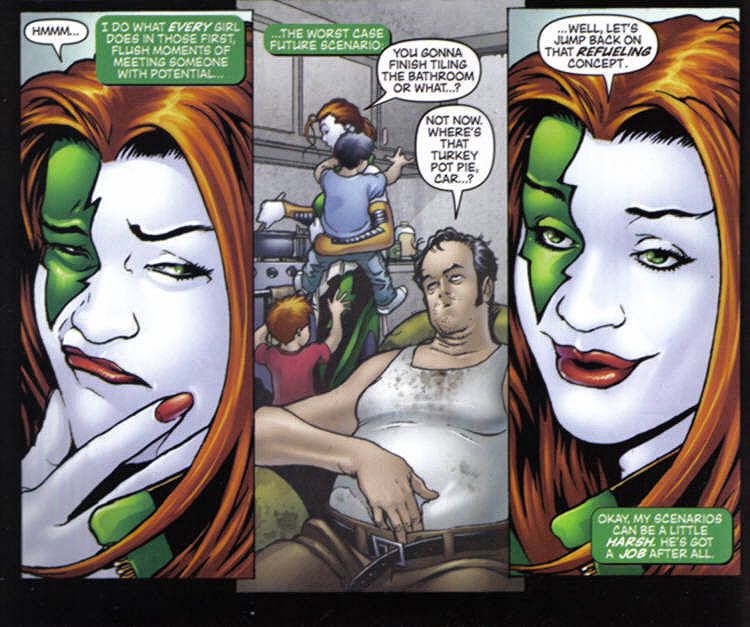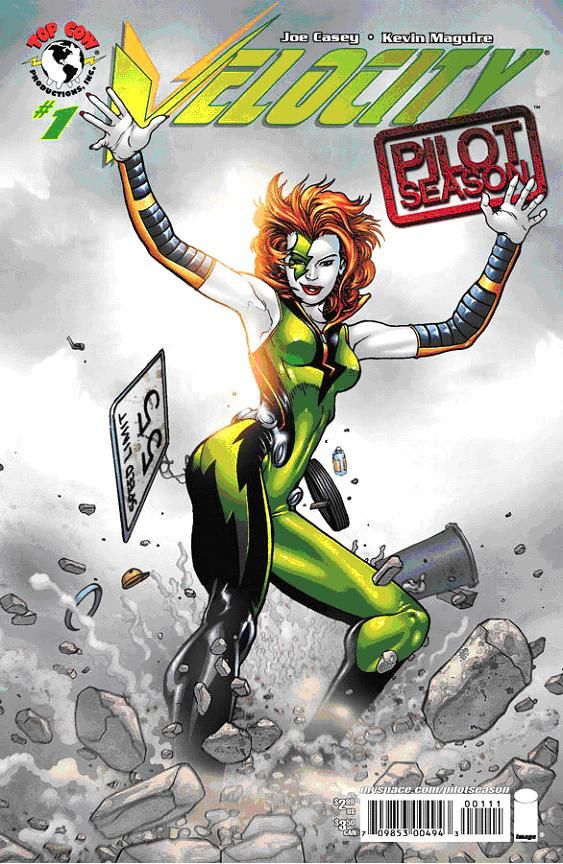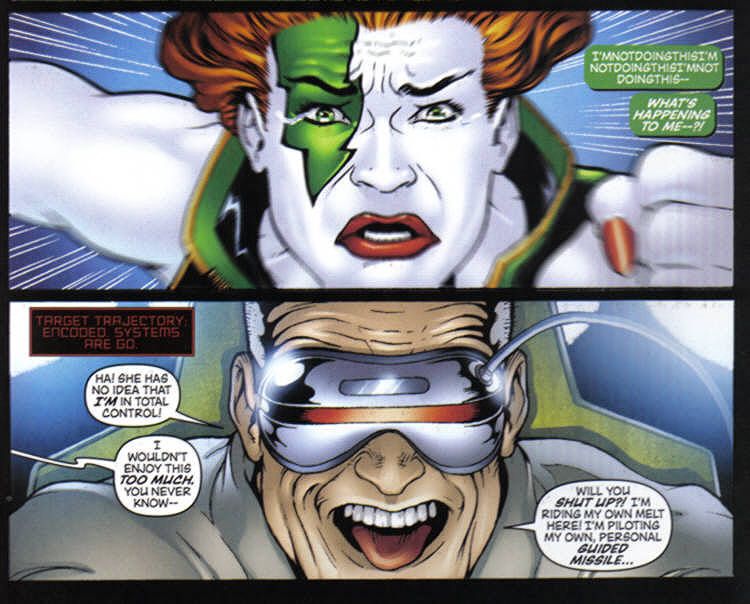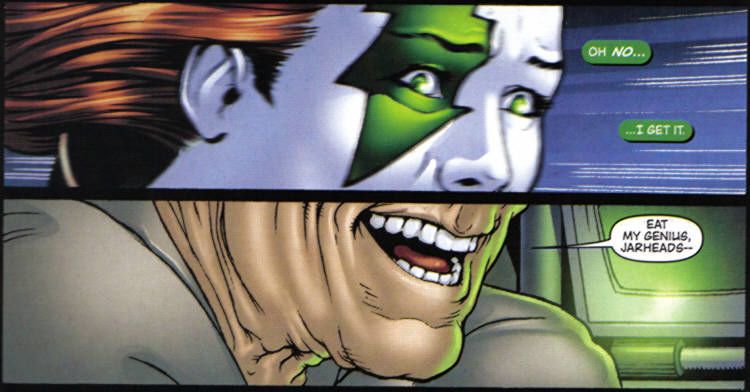For the second edition of the Reread Reviews, I'll be looking at a comic written by the writer I'm most closely associated with, Joe Casey. It's what people expect, so who am I to disappoint? As always, spoilers mean nothing to me, but they may mean something to you, so beware what lies below if that's the case.
I've been analysing Joe Casey's writing pretty steadily on my blog since participating in the Blogathon on July 28/29, 2007. The Blogathon is an annual charity event where people post on their blogs every 30 minutes while people sponsor them by contributing money to whatever charity said blogger selects (mine was the Alzheimer Society of Canada). Posting every 30 minutes for 24 hours meant a total of 49 posts, which is quite a bit to write in a day. My solution was to do many posts on three Joe Casey runs, issue by issue (along with other random posts): Mr. Majestic, Uncanny X-Men, and his final year on Adventures of Superman (which is my favourite Superman run of all time). After that, I continued to look at Casey's work, writing on Cable, Deathlok, The Incredible Hulk, Wildcats, The Intimates, The Last Defenders, and various "lesser known Joe Casey comics" (fill-in issues, one-shots, mini-series and annuals that most people have forgotten about). You can find the archive here.
My examination of Casey's work is by no means complete (I still need to write on Automatic Kafka, Iron Man: The Inevitable, everything-but-the-final-year of his Adventures of Superman run, his various titles that I call "Joe Casey Fills Stan Lee's Plotholes" (Earth's Mightiest Heroes, Children of the Atom, First Family, Enter the Mandarin), and assorted lesser known works. One of those lesser known works is Velocity: Pilot Season #1, which Casey did in 2007 with Kevin Maguire.
Top Cow's Pilot Season project first began in 2007 with the basic idea that Top Cow would release six first issues and readers could vote for their favourite. The two titles that got the most votes would be picked up as series. Velocity and Cyblade won that year (Jason Aaron's Ripclaw was one of the losers) and, while the Cyblade series has shown up, the promised Joe Casey/ChrissCross Velocity book never materialised. Casey recently explained what happened in a CBR interview promoting the duo's upcoming Final Crisis Aftermath: Dance:
Y’know, we were primed to do a Velocity series for Top Cow and although I wrote and got paid for three issues and Cross penciled a first issue that was so visually stunning and the best-looking thing Top Cow would’ve published this year, somewhere along the line that famous Top Cow brand of common sense disappeared into an unexpectedly bizarre rift in time and space, they started firing staff left and right – including our beloved editor – and our book was suddenly no more, resulting in an obviously broken promise to four million Pilot Season voters. Ouch.
I had actually been holding off looking at Velocity: Pilot Season #1 until the ongoing series was released and completed (whenever that would be) since I prefer to discuss complete Casey works, not in-progress series. Seeing as how there will be no Velocity series (although who knows if one will show up in the future with three scripts and one pencilled issue already finished), let's take a look at the book.
Velocity, for those not in the know, is a character from Marc Silvestri's Cyberforce, a group of cybernetically-enhanced folks that bear a shocking similarity to the X-Men and Wildcats (although, the latter is just Jim Lee and Silvestri ripping off the same source). Velocity runs very fast. That's about all you need to know.
I (briefly) posted my thoughts on this issue onGraphiContent when I first got it:
A nice little done-in-one story by Joe Casey with Kevin Maguire on art. I never really read Cyberforce, so I don't really know much about Velocity. Picked this up because of Casey and it's a decent read. Typical Casey dialogue--a sort of hipster casual (if that makes any sense). A story with a clever solution. A slightly downbeat ending. I haven't read any of the other "pilot season" books, but this could be a fun superhero series if it gets enough votes. Oh, and Maguire's art is excellent.
As you can see, I tend to keep things brief when discussing new comics on the blog most of the time. I don't really disagree with what I wrote then after rereading the issue again. I am a little more impressed with how well it works as a Velocity one-shot and as the possible beginning of a series. That no further issues came out doesn't hurt this comic one bit. It's a great example of a self-contained issue. You don't even need to know anything about Velocity's past since Casey and Maguire introduce her in a simple fashion: she runs fast thanks to cybernetics. What else do you really need to know? They drop in other details like her big sister, that she's an orphan, that she has a chip on her brain (which is integral to the plot), and other minor stuff that contribute to making Velocity the unique character she is, but not much of that is essential. It's a basic approach that's very new-reader friendly. As I said before, I never read Cyberforce, and I wasn't lost once. (Although my dad bought the book, so I did flip through issues at various points, absorbing some knowledge. Which leads me to a total tangent... I've always had this weird awareness of what's going on in comics. I may not read every book (and never have), but I always seem to have a general idea of what's going on. For example, I had never read a single issue of Spawn or read any articles about the comic, but I knew his entire origin story before the movie opened. How? No idea. It surprised me quite a bit at the time to find that, yeah, I knew quite about the character and book despite having no contact with either. *shrugs*)
Appropriately, the issue is titled "One Shot," and has a simple plot: Velocity delivering a kidney cross-country for transplant, getting some medical help with a sore shoulder, going on a date with a doctor, and then having her body taken over by a crazy scientist through the chip on her brain. He uses her as a super-speed weapon until she runs so fast that his computer can't keep up. Remember when superhero comics were nice and easy like that?
What makes this issue better than it seems is Casey's strong character work on Carin (Velocity's real name, which is only mentioned once, I believe), his trademark trippy dialogue and Maguire's art, especially his facial expressions and panel layouts.
The issue is narrated by Carin and Casey uses that to his full advantage in getting across who she is. Some it is lame or clichéd (like Carin telling us she hates lying still), but other bits give us insight into her messed up world. She's very self-aware, a quick thinker, constantly seeing what's going to happen next, so when a doctor asks her out, she already noted it would happen the page before. Not only that, but she "runs" ahead to how things may turn out:
Is that what every girl does or just her? (I don't actually know, so if someone wants to clue me in, I'd appreciate it. I'm going to assume it's just her...) And what does it say that she thinks every other woman does the same as her? Despite self-awareness displayed elsewhere, she views her weird neurotic tics as normal behaviour. It's an interesting contradiction.
Check out those facial expressions by Maguire! You don't need Casey's words to know exactly what she's thinking, even in that third panel. I really enjoy the look on the guy's face in the second panel.
Casey also does something interesting (and, depending on your views, bold) in having Carin openly think negative things about the doctor and, yet, still seem interested in pursuing a physical relationship with him. She clearly doesn't want anything long-term with the man -- and it's not meant to be self-destructive or a major flaw, she just hates standing still. She gets bored easily, even with people. Casey doesn't hit us over the head with these facets of her character, but there's enough to get the message.
Carin is also very confident in herself and her abilities. There are elements of her superhero persona that even she knows are false, but she does it well. Although, in some cases, her impulsive selfishness can't help but come through:
The villain of the issue, Professor Abel steals a medical scan of Velocity's brain to get information on the chip on her brain, which allows him to control her remotely. He uses her as a living missile, destroying a military base until she runs so fast that she outruns the signal that he's using to connect her brain to his computers. In the process, she creates a worldwide sonic boom. The problem and solution is appropriate and clever as Casey tailors both to Velocity specifically. The villain targets her for a specific reason and, then, she uses that same reason against him.
Not only that, but the comparison between Carin and Velocity is central in the story, as what makes Velocity such a good hero is what inhibits Carin's personal life: super speed. It's a great superpower and she uses it very well, but it also prevents her from forming meaningful connections. Her mind moves too fast for others and not in that stupid way where she reads books at super speed or is more intelligent, but in that she's always moving beyond others emotionally. She needs entertainment at a more rapid pace, regular human interaction just can't keep up. (Another tangent: nothing annoys me more in super speed characters than when they run away and read entire books at super speed. Yes, they could do that, theoretically, but how many of us sit down and read entire books in one sitting? That most don't isn't because of a lack of time (exclusively), it's because reading can grow tiring and you need a break. This has grown more prominent thanks to the internet and TV where people are conditioned for short attention spans, so how much luck would a super speedster (a person whose very nature conditions them for short attention spans) have in reading entire books in one go? Stoopid comics.)
Kevin Maguire is essential to pulling this off as he uses a lot of long, horizontal panels, but also works to show the connection between Abel and Velocity. First, by contrasting their expressions:
And, then, by showing how they're occupying the same space, as it were:
Both examples not only work very well, but work best here, as a comic. Seeing the contrast in their juxtaposed faces could be pulled off in a movie or TV show, but is most effective if you can see both faces at the same time. That no one can match Maguire in drawing faces is a big part of why this is so effective. The second example, though, can only be done in comics since the panel positioning is essential in making the connection between the two half of Velocity's face and the bottom half of Abel's. Velocity is terrified, while Abel is clearly having the time of his life.
It's a shame that the promised Velocity series never happened, but I was also a little worried that Maguire's absence would hurt the series. All in all, a good read.
Next week, I'm thinking something by Jim Starlin may be necessary.
(A note on scans: I won't always use them. It depends on the book and the format I own it in. Individual issues are far likelier to get scanned than trades.)





